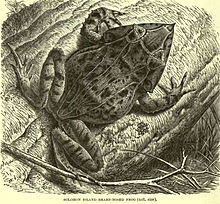Ceratobatrachidae
| Ceratobatrachidae | |
|---|---|
 |
|
| Ceratobatrachus guentheri | |
| Scientific classification | |
| Kingdom: | Animalia |
| Phylum: | Chordata |
| Class: | Amphibia |
| Order: | Anura |
| Superfamily: | Ranoidea |
| Family: |
Ceratobatrachidae Boulenger, 1884 |
| Type genus | |
|
Ceratobatrachus Boulenger, 1884 |
|
| Genera | |
|
5, see text. |
|
| Synonyms | |
|
Ceratobatrachinae |
|
5, see text.
Ceratobatrachinae
The Ceratobatrachidae are a family of frogs found in the Malay Peninsula, Borneo, the Philippines, Palau, Fiji, New Guinea, and the Admiralty, Bismarck, and Solomon Islands.
The Ceratobatrachidae have formerly been treated as a subfamily (i.e., Ceratobatrachinae) in the Ranidae family (true frogs), but they do not seem to be particularly closely related to other former ranids. The five genera are:
The largest genus, Platymantis, is known to be paraphyletic. Solving this problem will likely lead to a more narrowly defined Platymantis, possibly by transferring some species (together with Batrachylodes) to a larger Ceratobatrachus.
In addition, "Ingerana" baluensis (Boulenger, 1896) is placed incertae sedis in this family, as opposed to Dicroglossidae where the rest of Ingerana are.
All Ceratobatrachidae lay eggs outside of water and undergo direct development where eggs hatch directly into froglets, without free-living tadpole stages.
...
Wikipedia
